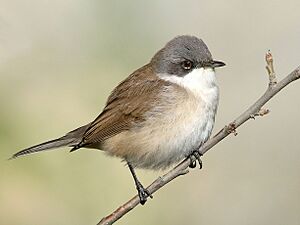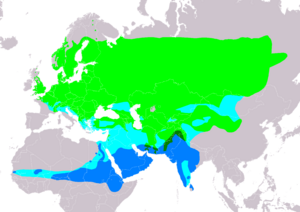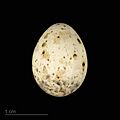Lesser whitethroat facts for kids
Quick facts for kids Lesser whitethroat |
|
|---|---|
 |
|
| in Pakistan | |
| Conservation status | |
| Scientific classification | |
 |
|
| Range of S. curruca (Compiled by: BirdLife International and Handbook of the Birds of the World (2019) 2018.) Breeding Resident Passage Non-breeding | |
| Synonyms | |
The lesser whitethroat (Curruca curruca) is a common little bird found across Europe and parts of Asia. It's a type of warbler, known for its sweet songs. This small bird is a migratory champion, flying all the way to Africa, Arabia, and India for the winter.
Lesser whitethroats are hard to tell apart, whether they are male or female. They have a grey back, a white belly, and a grey head. A darker patch of feathers goes through their eyes, like a little mask. Their throat is bright white. They are a bit smaller than their cousin, the common whitethroat. You can tell them apart because lesser whitethroats don't have chestnut-colored wings. Their song is also different, sounding like a fast, rattling "tet" or "che" sound.
Like most warblers, these birds mainly eat insects. But they also enjoy berries and other soft fruit, especially when insects are scarce. You can often spot them in open areas with lots of bushes and some trees, which they use for nesting.
Contents
About the Lesser Whitethroat
Lesser whitethroats prefer open spaces and farms. They like areas with big bushes where they can build their nests.
Diet and Habits
These birds are mostly insectivorous, meaning they love to eat insects. This helps keep insect populations in check. When it's not breeding season, or when insects are harder to find, they will also eat berries and other soft fruit.
Reproduction and Nesting
Lesser whitethroats build their nests in low shrubs or thorny bushes, like brambles. The female bird usually lays between 3 and 7 eggs. Both parents work together to raise their young.
Naming and Family Tree
The lesser whitethroat was first officially described in 1758 by a Swedish scientist named Carl Linnaeus. He gave it the scientific name Motacilla curruca. The word curruca comes from an old Latin word for a bird. Later, scientists moved it to a different group, or genus, called Curruca.
How Scientists Study Bird Families
For a long time, people thought the lesser whitethroat was very closely related to the common whitethroat. This was because their common names are similar. Scientists believed they might have split into two different species during the last ice age. This is similar to how the chiffchaff and willow warbler became separate species.
However, modern scientists have learned that these two "whitethroats" are not actually very close relatives. Instead, the lesser whitethroat and its closest family members, like Hume's whitethroat, seem to be related to other birds that look quite different. These relatives often have dark head sides and white throats, but they don't have chestnut wing patches.
This suggests that the lesser whitethroat's family split off a very long time ago. This separation might have happened because the Arabian region became very dry, rather than because of ice sheets in Europe.
Different Types of Lesser Whitethroats
Scientists recognize several different types, or subspecies, of the lesser whitethroat. These subspecies can be found across Europe and Asia. They can look slightly different from each other. For example, the Northeastern lesser whitethroat has a paler head.
Here are some of the recognized subspecies:
- Curruca curruca curruca – This is the Western lesser whitethroat, found in the western parts of its range.
- Curruca curruca blythi – Known as the Northeastern lesser whitethroat, found in the eastern parts of its range. It has a slightly paler head.
- Curruca curruca halimodendri – Found in places like southeastern Russia and Kazakhstan.
- Curruca curruca althaea – Called Hume's whitethroat, found from Iran to central Asia.
- Curruca curruca minula – Known as the Desert whitethroat, found from southern Kazakhstan to western China.
- Curruca curruca margelanica – Found in northern China.
Sometimes, birds from different subspecies might mix. Scientists are still studying these birds to understand their family tree completely.
Gallery






